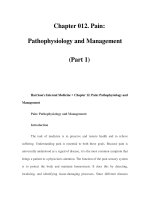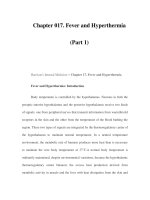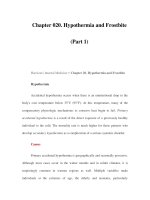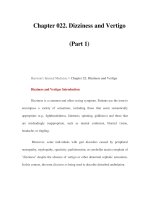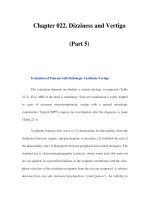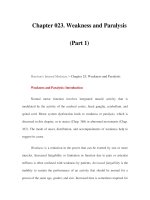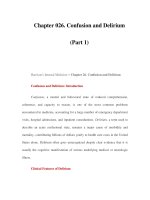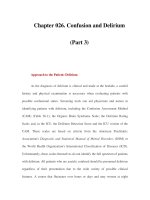Chapter 050. Hirsutism and Virilization (Part 1) pptx
Bạn đang xem bản rút gọn của tài liệu. Xem và tải ngay bản đầy đủ của tài liệu tại đây (11.02 KB, 5 trang )
Chapter 050. Hirsutism and
Virilization
(Part 1)
Harrison's Internal Medicine > Chapter 50. Hirsutism and Virilization
Hirsutism and Virilization: Introduction
Hirsutism, defined as excessive male-pattern hair growth, affects
approximately 10% of women. It usually represents a variation of normal hair
growth, but rarely it is a harbinger of a serious underlying condition. Hirsutism is
often idiopathic but may be caused by conditions associated with androgen excess,
such as polycystic ovarian syndrome (PCOS) or congenital adrenal hyperplasia
(CAH) (Table 50-1). Cutaneous manifestations commonly associated with
hirsutism include acne and male-pattern balding (androgenic alopecia).
Virilization refers to a condition in which androgen levels are sufficiently high to
cause additional signs and symptoms such as deepening of the voice, breast
atrophy, increased muscle bulk, clitoromegaly, and increased libido; virilization is
an ominous sign that suggests the possibility of an ovarian or adrenal neoplasm.
Table 50-1 Causes of Hirsutism
Gonadal hyperandrogenism
Ovarian hyperandrogenism
Polycystic ovary syndrome/functional ovarian hyperandrogenism
Ovarian steroidogenic blocks
Syndromes of extreme insulin resistance
Ovarian neoplasms
Adrenal hyperandrogenism
Premature adrenarche
Functional adrenal hyperandrogenism
Congenital adrenal hyperplasia (nonclassic and classic)
Abnormal cortisol action/metabolism
Adrenal neoplasms
Other endocrine disorders
Cushing's syndrome
Hyperprolactinemia
Acromegaly
Peripheral androgen overproduction
Obesity
Idiopathic
Pregnancy-related hyperandrogenism
Hyperreactio luteinalis
Thecoma of pregnancy
Drugs
Androgens
Oral contraceptives containing androgenic progestins
Minoxidil
Phenytoin
Diazoxide
Cyclosporine
True hermaphroditism
